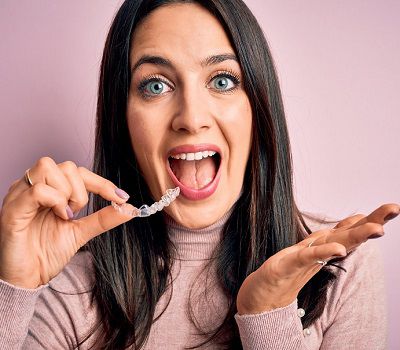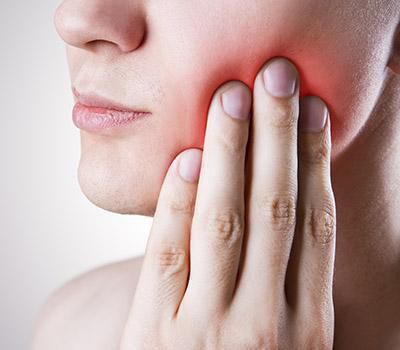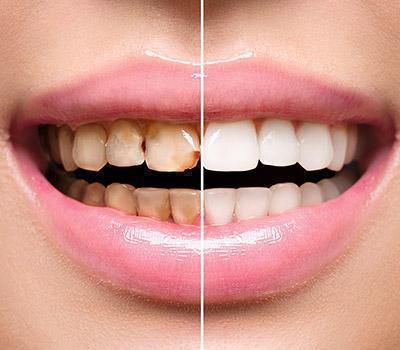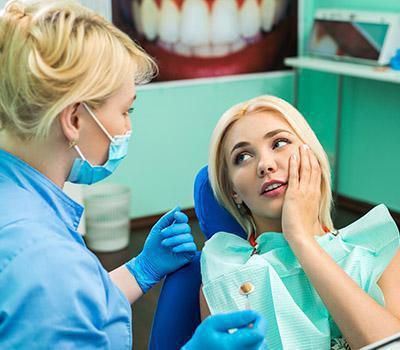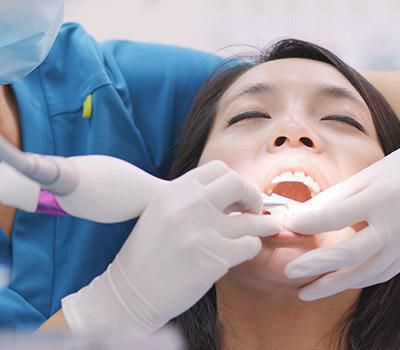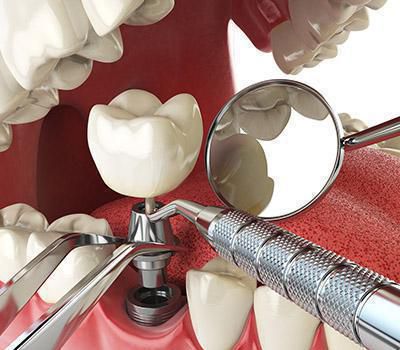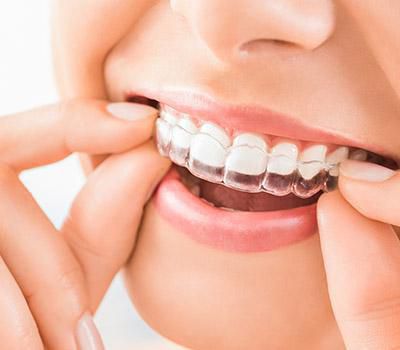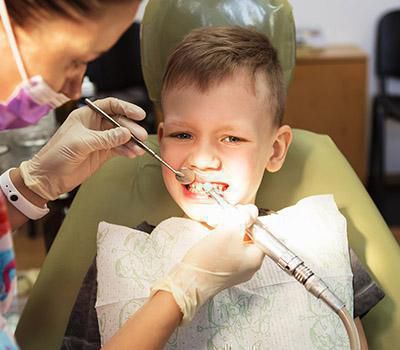Mouthguard
The treatment of TMJ dysfunction with an occlusal guard is the single biggest misunderstood topic in dentistry. An occlusal guard or night guard is what many people think is “a mouth guard for TMJ,” but is it really?
Well, actually, treating TMJ is much more than a store-bought occlusal guard or even a custom TMJ mouthguard. You probably won’t see good results if you wear a night guard and call it a day.
If you’ve been wearing an occlusal guard and are still suffering from symptoms, there is hope. Dr. Kaur designs occlusal guards using a scanner/3D printer method, and the cost is $690 and also covers necessary adjustments to improve TMJ disorders.
This article will help to demystify how a mouth guard for TMJ works successfully. And equally important, what might be wrong about your night guard if you’re not getting relief.
The Misunderstanding: What Most People Think About an Occlusal guard
If a dentist recommended you an occlusal guard, what would you think? Most likely you’re thinking… it’s a way to protect your teeth from damage from things like clenching or grinding. It’s a night guard to protect my teeth, right?
If you thought that, don’t worry, you are not alone! It’s partially correct, but sadly missing a big component.
Here’s the reality: If you’re grinding and clenching your teeth, there’s usually an underlying cause. Most people don’t clench and grind for no reason. Teeth grinding is hinting that something in the bite is unsettled that’s triggering that grinding motion.
Think of it this way. Have you ever had a sunburn and tried to go to sleep? You’ve probably tossed and turned because your skin is irritated. Teeth grinding is similar. The position of the jaw is irritating so the mouth clenches and grinds to try to find a more comfortable space.
Now here’s where things often go wrong with TMJ.
Most dentists recommend an occlusal guard or a nightguard to protect the teeth from wearing down. It’s not only about the teeth. That’s like tossing and turning from sunburn and trying to protect the bedsheets from wearing away. Protecting the teeth is important, but it’s not really addressing what’s causing the grinding in the first place.
TMJ Pain Begins Because of Disharmony
TMJ pain is most commonly caused because of a disharmony in the TMJ complex. The TMJ complex directly includes the temporomandibular joints, the muscles, and the maxilla/mandible.
Think of the TMJ complex like a hammock. Just like a hammock, the TMJ complex must work in unison and balance.
For example, a person laying in a swinging hammock is comfortable when they lay in the middle. However, when there is an uneven load on the hammock, it feels unstable. The person tenses their muscles to counterbalance themselves to avoid falling. It’s a constant awareness of the instability. TMJ pain is the same way. The jaws, muscles, or joints are out of harmony. The instability creates discomfort.
So what does TMJ disharmony look like? The answer to this question is what often mystifies the topic. The disharmony is formed by several different sources that each begin to compensate for each other. This makes the origin of the problem less obvious and why many dentists are even bewildered.
Some patients with TMJ dysfunction may even present with beautifully orthodontically aligned teeth—yet still have headaches, jaw pain, earaches, or soreness. The teeth are easy to see, but its not so obvious if the teeth are out of harmony from the TMJ, maxilla, mandible, or muscles. You can imagine it’s difficult to visualize the root of the problem when your dentist can’t see the cause clearly just by looking at the teeth.
Now, here’s the big takeaway point. Regardless of the source of TMJ dysfunction, by altering the position of function, many of the symptoms improve. The studies and research back it up. So if you’re wearing a mouth guard for TMJ and are still suffering, guess what the solution is?
Pretty obvious spoiler alert: Test more jaw positions by adjusting the TMJ mouthguard.
The Hammock Theory of TMJ Disorder

An Occlusal Guard Takes the Teeth Out of the Equation
So how do we alter the position of the jaw function? It sounds complicated but really..it’s not. The answer is…we test it. That’s where occlusal orthotics come in.
Occlusal guards, or as we should call them orthotics, are a common first step to TMJ therapy. I want you to think of them as an experiment. Here’s what I mean:
Occlusal guards are a simple, reversible way to test how symptoms respond when the jaw opens and closes at a new position. They take the teeth out of the equation.
When the teeth are out of the equation it affects not only the teeth, but the position at which the top and bottom jaw orient to one another. Because the plastic of an occlusal guard can be designed in any position it serves as a way to equilibrate the position at which the maxilla, mandible, and TMJs are most comfortable.
Once we can confirm that symptoms improve with a new position, the feedback is gold. We can use that position to figure out what’s causing the pain when the TMJ mouthguard isn’t in. That’s how we determine treatment.
A mouthguard for TMJ really just provides us information on how the symptoms respond in different jaw positions.
So you may be wondering, how does the occlusal guard (orthotic) physically change the jaw position to align it? It’s based on finding the orientation that works best to relieve symptoms. That’s all. The position may be more forward than the teeth allow the jaw to close in. It may be further back. It might balance the right versus the left if one side hits harder than the other. There’s a number of different combinations that could put our TMJ out of harmony left or right.
What about people who are missing teeth? Do you think that a tooth that once existed but is now missing can affect the harmony? You bet it can.
All these factors can be accounted for in an occlusal guard and neutralized into better balance. That’s why its an experiment…we are looking to see when we make changes to these discrepancies, how do the symptoms respond?
How Do We Find the Ideal Position for a TMJ Mouthguard?
That’s where the majority of dentists go wrong. It requires a significant amount of experience to understand how to fine-tune the position of a TMJ mouthguard. So what do most dentists do that are not trained in TMJ treatment? They create a guard that is based on the patient’s current bite. If we create the exact same jaw position with the occlusal guard, why would anything change?
The reality is a mouth guard for TMJ should be adjusted over a period of months until the symptoms improved. If the jaw could close in the most comfortable position, that’s the position we want!
That takes time and a few adjustments of the TMJ mouthguard to achieve. It’s not just handing the patient a night guard and telling them, “come back in six months.”
The best night guards are designed to be adjusted over 3 to 4 months.
Oh and speaking of that, the term night guard is also a misnomer when it comes to TMJ treatment. A mouthguard for TMJ often needs to be worn during the day as well as a night guard. Well at least if you want it to work.
It’s a simple matter of time. If you’re only wearing it as a night guard that’s only a third of the time. If you’re jaw’s out of balance for two thirds the day, then you’re probably not going to see ideal results.
Improving TMJ Dysfunction Heals Multiple Symptoms
The TMJ complex is just like a hammock that requires a certain level of balance and stability. Instability of the system creates tension and inflammation. That leads to a variety of diverse symptoms that often can even feel unrelated to one another.
Here’s whats going on. The system is overloaded and out of tune. TMJ disorder may progress to the point where the entire head tries to compensate. That’s why a patient with TMJ dysfunction can present with headaches, tinnitus, neck pain, or earaches from jaw function.
It seems unrelated until you consider that the muscles of the head are working overtime trying to help the jaw muscles, and the inflammation from the TMJs is but a mere ½ centimeter away from the middle ear. The tension from the jaw spreads to the neighboring areas.
As you can see, the symptoms of TMJ dysfunction can be widespread throughout the head and neck. Symptoms may even become debilitating. You wouldn’t believe how many people with TMJ type symptoms come into my office crying on their first visit. The symptoms can be downright overwhelming.
Symptoms that commonly related to TMJ dysfunction are muscle fatigue, temporomandibular joint soreness, headaches, clenching/grinding, insomnia, ear pain, lockjaw, difficulty opening/closing the jaw, and stress.
The good news is by improving the balance of the jaw many of these symptoms completely resolve.
A properly designed occlusal guard, TMJ mouthguard, orthotic, piece of plastic (whatever name you want to call the appliance), allows a TMJ specialist to balance the harmony of the TMJ. Either way, the goal is a better balance.
Over a period of months, different positions can be tested in a reversible way.
How a Mouth Guard for TMJ is Not the Final Treatment
Whoa, an occlusal guard is not a definitive treatment? Shocker.
But, Dr. Sutera, you just told me about all those wonderful benefits it has on improving the harmony of the TMJ complex. Yes, but its just the first phase of TMJ treatment.
I lecture to other dentists about structuring TMJ treatment into two phases. The first phase is always testing in a reversible way. If the symptoms improve, we move to the next step. If you can’t get the symptoms to improve with the TMJ mouthguard, guess what? We need to consider more factors before doing anything permanent to the teeth.
The point I want you to understand is that an occlusal guard or TMJ mouthguard is two things. It’s both diagnostic and therapeutic. It should not only protect the teeth, but improve the position of the TMJ. A mouth guard for TMJ is primarily used to determine if the symptoms improve when it’s worn compared to when it’s not.
If your symptoms worsen when you’re not wearing the occlusal guard, it indicates there’s more to the story. Either the TMJ mouthguard is in the wrong position, or there could be something else going on like neurological, anatomical, or inflammatory.
Although an occlusal guard may be used a definitive treatment to improve TMJ dysfunction, who would want to commit the rest of their life to wearing a plastic appliance?
The best option is to have a TMJ specialist use the feedback from the occlusal guard to determine a more permanent treatment. Just as the occlusal guard can change your jaw harmony by laying plastic over your teeth, your teeth can be altered to improve the TMJ symptoms. That’s what I call phase II of TMJ treatment.
Some non-invasive treatments that may be considered to permanently improve TMJ pain are orthodontics, botox, occlusal equilibration, and restorative dentistry. After investing in these treatments to improve the TMJ complex harmony, many patients may no longer have TMJ symptoms. The goal is for the patient to no longer need a TMJ mouthguard for their symptoms.
Its’s also important to understand the value of using an occlusal orthotic if the symptoms of pain do not improve. That’s right, I said IF they do NOT improve. There are some less common TMJ conditions which do not improve by changing the position of the jaw. These conditions are usually related to neurology or severe anatomical defects. It is a powerful advantage that an occlusal guard is reversible. If symptoms are not improving with an occlusal guard, it prevents the patient from entering into non-reversible treatment with false expectations.
That my friends is how occlusal guard and mouth guards for TMJ should actually be used. And as we’re wrapping up, I’ll touch on one last thing.
What about an over-the-counter occlusal guard? Do they work?
At the time of this writing, there is not an over the counter occlusal guard that is FDA cleared for TMJ treatment. They are only cleared to protect the teeth for grinding. So, if you’ve purchased an over the counter occlusal guard trying to treat TMJ, don’t be alarmed if you don’t get ideal results. They’re not designed for that purpose. They are designed to prevent the teeth from wearing.
That’s everything you wanted to know about mouthguards for TMJ (and even some you didn’t want to know)
Someone once said, “if you can’t say it better yourself, let someone else, and go out strong.” And so I’ll leave you with this. A quote from one of the greats who had a life dedicated to providing us with joy and happiness.
Walt Disney is famous for saying, “I hope we never lose sight of one thing – that it was all started by a mouse.”
That’s a quote I always remember. It takes something that is incredibly complex and simplifies it to what really matters–where it all began. What can be more powerful?
The key to understand with TMJ treatment is…it all starts with an occlusal orthotic. Regardless how complex the case is, that’s usually where we begin treating the patient. A mouth guard for TMJ is a simple, reversible way to evaluate how your symptoms respond before deciding on any further treatment.
This article is taken from https://www.aestheticsmilereconstruction.com/2020/09/11/how-tmj-therapy-works-with-an-occlusal-guard-or-mouth-guard-for-tmj/ . It is written by Charles Sutera DMD, FAGD. He is a nationally acclaimed dentist known for high-profile smile makeovers, complex TMJ treatment, and IV sedation dentistry for the most dental-phobic patients in the country.
Location
1920 West Grant Line Road,
Tracy, CA 95376
Phone: (209) 820-0789
Fax: (209) 221-0167
Office Hours
MON - THU 8:30 am - 5:30 pm
FRI By appointments only.
SAT - SUN Closed



